Translate this page into:
Fractional derivative of the Hurwitz ?-function and chaotic decay to zero
?Corresponding author. ccattani@unisa.it (C. Cattani),
-
Received: ,
Accepted: ,
This article was originally published by Elsevier and was migrated to Scientific Scholar after the change of Publisher.
Peer review under responsibility of King Saud University.
Abstract
In this paper the fractional order derivative of a Dirichlet series, Hurwitz zeta function and Riemann zeta function is explicitly computed using the Caputo fractional derivative in the Ortigueira sense. It is observed that the obtained results are a natural generalization of the integer order derivative. Some interesting properties of the fractional derivative of the Riemann zeta function are also investigated to show that there is a chaotic decay to zero (in the Gaussian plane) and a promising expression as a complex power series.
Keywords
Fractional calculus
Riemann zeta function
Hurwitz function
Dirichlet series
1 Introduction
In recent years, fractional calculus has more and more become one of the most suitable tools for research both in theory and in applications, spreading over almost all fields of science and technology. For instance, fundamental problems of fracture mechanics, electromagnetism, speech signals, sound wave propagation in rigid porous materials, fluid mechanics, viscoelasticity, and edge detection, were easily solved and correctly explained using fractional calculus (Dalir and Bashour, 2010; Tarasov, 2008, 2006). In particular, because of the local definition of differential operators, the local approach of fractional calculus has opened new perspectives in scientific investigation with many interesting results (Bhrawy and Abdelkawy, 2015; Liu et al., 2014; Yang et al., 2013a,b; Zhao et al., 2013).
A very interesting topic is the geometrical interpretation of fractional operators. In fact, like the integer order derivative that gives the linear approximation of smooth (differentiable) functions, it should be expected that fractional derivative might give the non-linear approximation of the local behavior of non-differentiable functions (see e.g. Wang, 2012), thus opening new perspectives in research, by the investigation of fractional derivatives on non-differentiable sets, like the Cantor sets (Liu et al., 2014; Yang et al., 2013a,b; Zhao et al., 2013) or by investigating the non-differentiability of some special functions.
Almost all special functions are functions of complex variables (Abramowitz and Stegun, 1964). For this reason, the Ortiguera definition of fractional derivative of complex functions (Li et al., 2009; Ortigueira, 2006) seems to be the most suitable tool for studying complex functions. Using the Ortiguera fractional derivative we will give, in the following, the explicit form of the fractional derivative of the Hurwitz and Riemann ?-function together with some properties thereof. The famous Riemann ?-function is a special case of the more general Hurwitz ?-function which is a Dirichlet series. So, we will compute first the Ortiguera fractional derivative of the Hurwitz ?-function to obtain the fractional derivative of the Riemann ?-function as a special case (for preliminary results see also Guariglia, 2015). There are several applications of the analysis of Riemann ?-function in physics, such as in the scattering inverse methods where quantum potentials correspond to zeroes of the Riemann zeta (Schumayer et al., 0562; Sierra, 2010), or in the chaotic behavior of quantum energy levels related to these zeroes (Pozdnyakov, 2012). To this goal we will show in Section 4.1 that the fractional derivative of the Riemann ?-function also decays chaotically to zero. In particular, as application to a dynamical system we will show that zero is an attractor for this fractional derivative. Our aim is to compute the Caputo-Ortiguera fractional derivative of the Hurwitz zeta function and show its main properties.
2 Preliminary remarks on Riemann and Hurwitz zeta function
2.1 Riemann ?-function
The Riemann zeta function is defined as:
It is a Dirichlet series (Apostol, 2010, chp. 11) which converges absolutely to an analytical function for all complex numbers s such that
. This function owns an integral representation (Riemann, 1859; Guariglia, 2015; Edwards and Riemann's, 1974; Hardy, 1991), i.e.
We recall that the Dirichlet series is defined as follows:
Definition 1 Dirichlet series
A Dirichlet series is the series (Apostol, 2010):
Clearly the Riemann zeta function is a special Dirichlet series, with .
Thanks to its integral representation (2.2) it can be shown (Cattani, 2010) that:
Based on the above considerations, Hardy conjectured that the zeroes not only lie on the line but also there exist infinitely many non-trivial zeroes on this critical line (Beliakov and Matiyasevich, 2014; Hardy, 1914; Hardy and Littlewood, 1921; Derbyshire, 2004).
2.2 Hurwitz ?-function
The Hurwitz zeta function is defined as:
Also this function admits an integral representation (Apostol, 2010, chp. 12): with . So, this function can be easily expressed in terms of the Mellin transform (Whittaker and Watson, 1927).
The Hurwitz zeta function was first introduced in the problem of analytic continuation of the Dirichlet L-function (Mollin, 2008, 2010), i.e. a function defined by a Dirichlet L-series. In fact, if is a Dirichlet character modulo k, it can be shown that (Apostol, 2010, p. 249): so that the Hurwitz Zeta functions are a sum of L-functions (Boyadzhiev, 2008).
3 Remarks on fractional calculus
Let us start with the Cauchy formula of repeated integration: where f is a continuous function on the interval with (Lazarevic, 2014). This formula suggests us a suitable generalization to a repeated integral of any real order . By replacing the factorials with Gamma function, being , and the integer order n of the above with some real value we have the following:
Definition 2 Fractional (order) integral
Given , the fractional integral of order of a continuous function f is the operator :
The fractional derivative in the Caputo sense (Caputo, 1967) is defined through a fractional integral, as follows:
Definition 3 Caputo fractional derivative
The fractional derivative of order
, of a
-differentiable function
is defined as:
This definition holds true for all real powers (Boyadjiev et al., 2005), including negative or null values. In fact, for , it is while for it is . Thus, in the fractional calculus, the two operators integration and differentiation are unified as one single operator, sometime called differintegral (Lazarevic, 2014; de Oliveira and Tenreiro, 2014).
As a consequence of its definition we have:
For a given , and any function f such that its fractional integral exists it is:
(1)
(2) .
It follows directly from the definition of fractional integral operator (see e.g. Kamata and Nakamula, 2002; Lazarevic, 2014). ?
For other properties about the differintegral defined from the Riemann-Liouville and Caputo approaches, see also (Kamata and Nakamula, 2002; Lazarevic, 2014; Bagley, 2010).
Based on the Caputo derivatives we give now a suitable generalization of fractional derivative of complex functions (Guariglia, 2015; Li et al., 2009; Ortigueira, 2006).
Definition 4 Ortigueira fractional derivative
The Ortigueira
-derivative of a given complex function
, is defined as (Cattani, 2010; Guariglia, 2015):
Using this definition, we can obtain the fractional -derivative of a complex function along the -direction of the complex plane. This is a natural generalization of the Caputo derivative, because for a real function, i.e. , we re-obtain (3.1) (Li et al., 2009).
4 Fractional derivatives of the Dirichlet Series and of the Hurwitz zeta function
In this section, the fractional derivative of a function defined by a Dirichlet series (Apostol, 2010, chp. 11), is given. As a consequence we can easily define both the fractional derivative of the Hurwitz zeta function and as a special case of the Riemann zeta function.
The fractional derivatives of the Dirichlet series (2.3) and of the Hurwitz zeta function (2.5) are given by:
Let us start with the general form of a Dirichlet series given by (2.3). Using (3.2), we have (Apostol, 2010, chp. 11):
The last integral on the RHS of this equality has been already given in Guariglia (2015), as
where,
. There follows that: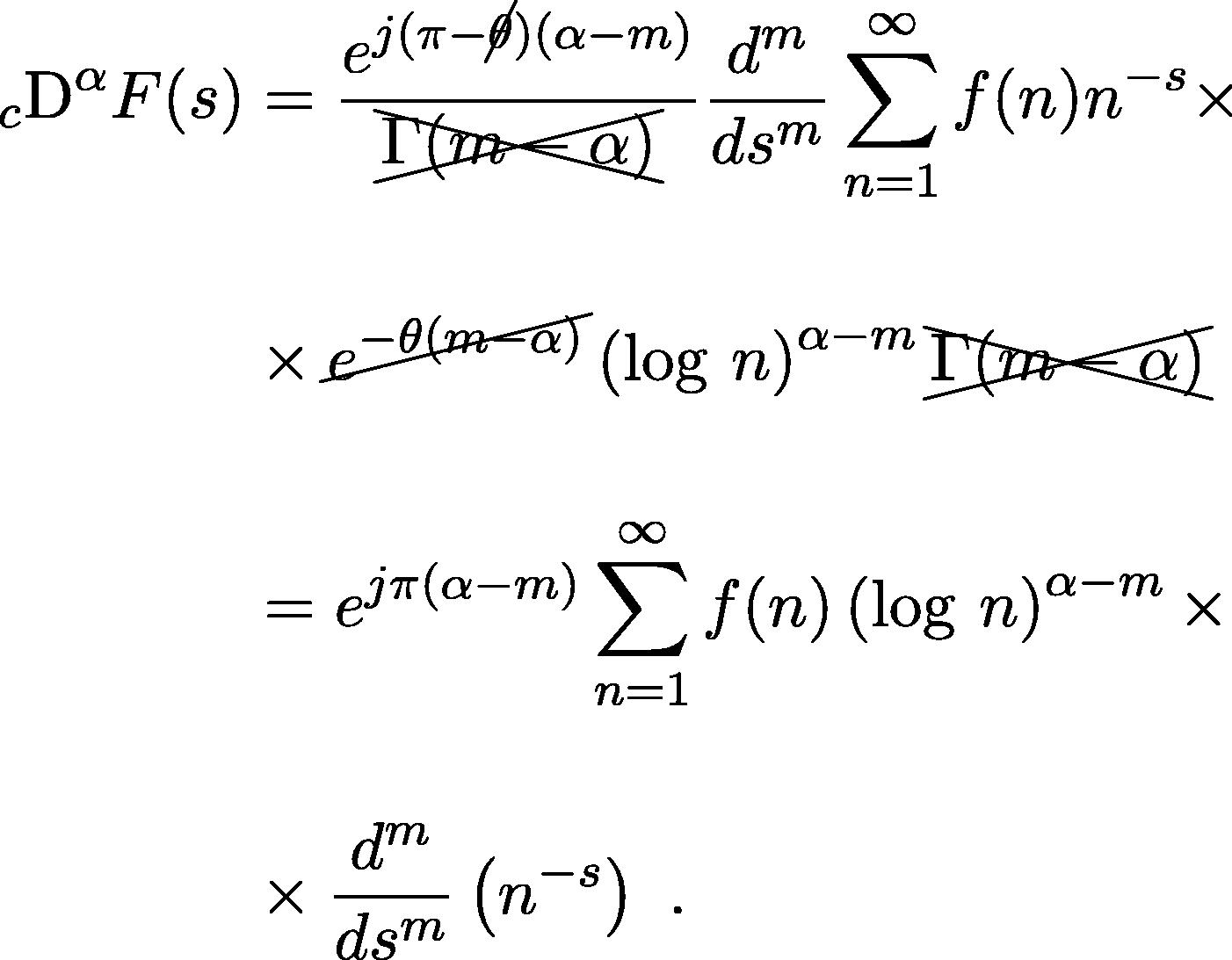
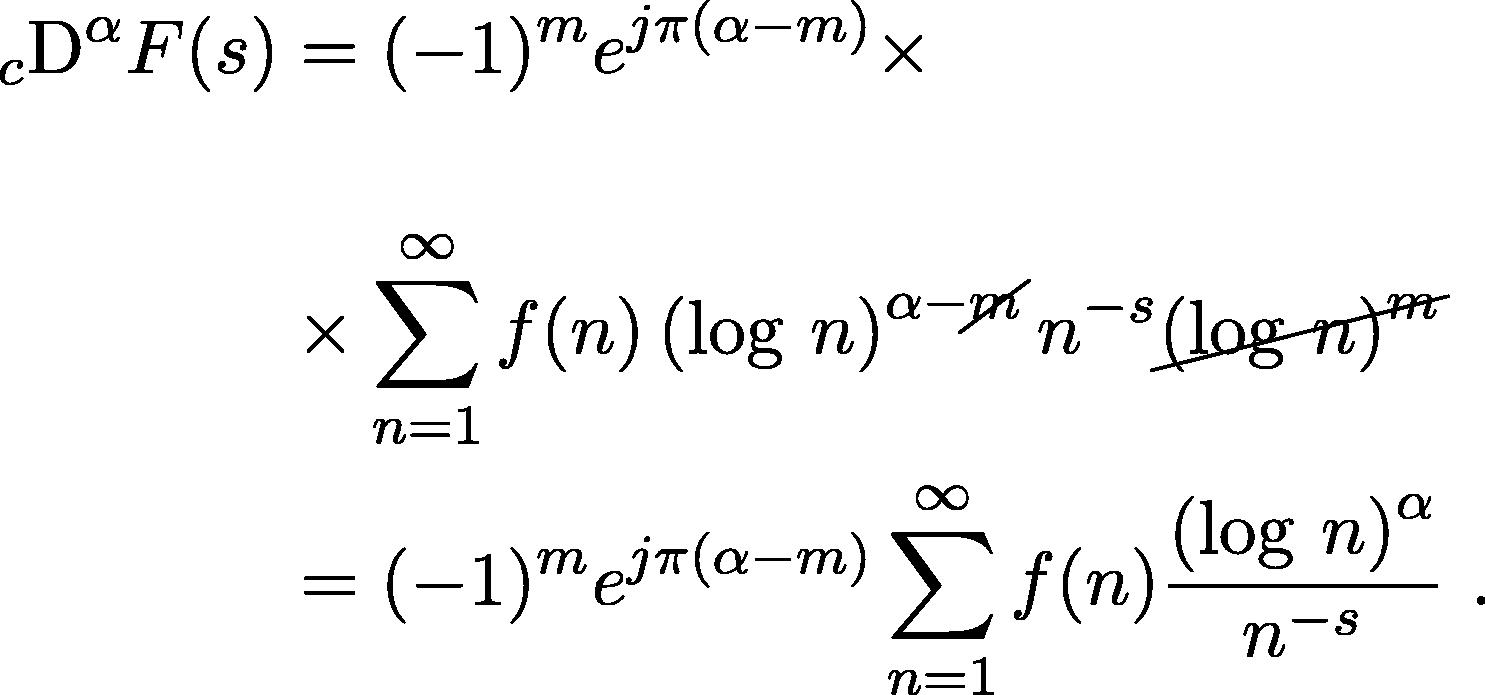
The computation of the fractional derivative of the Dirichlet series enables us to easily compute also the corresponding derivative of the Hurwitz zeta function. In fact, in the previous equation, by writing
, we get:
If we call I the last integral of the RHS, we have that: 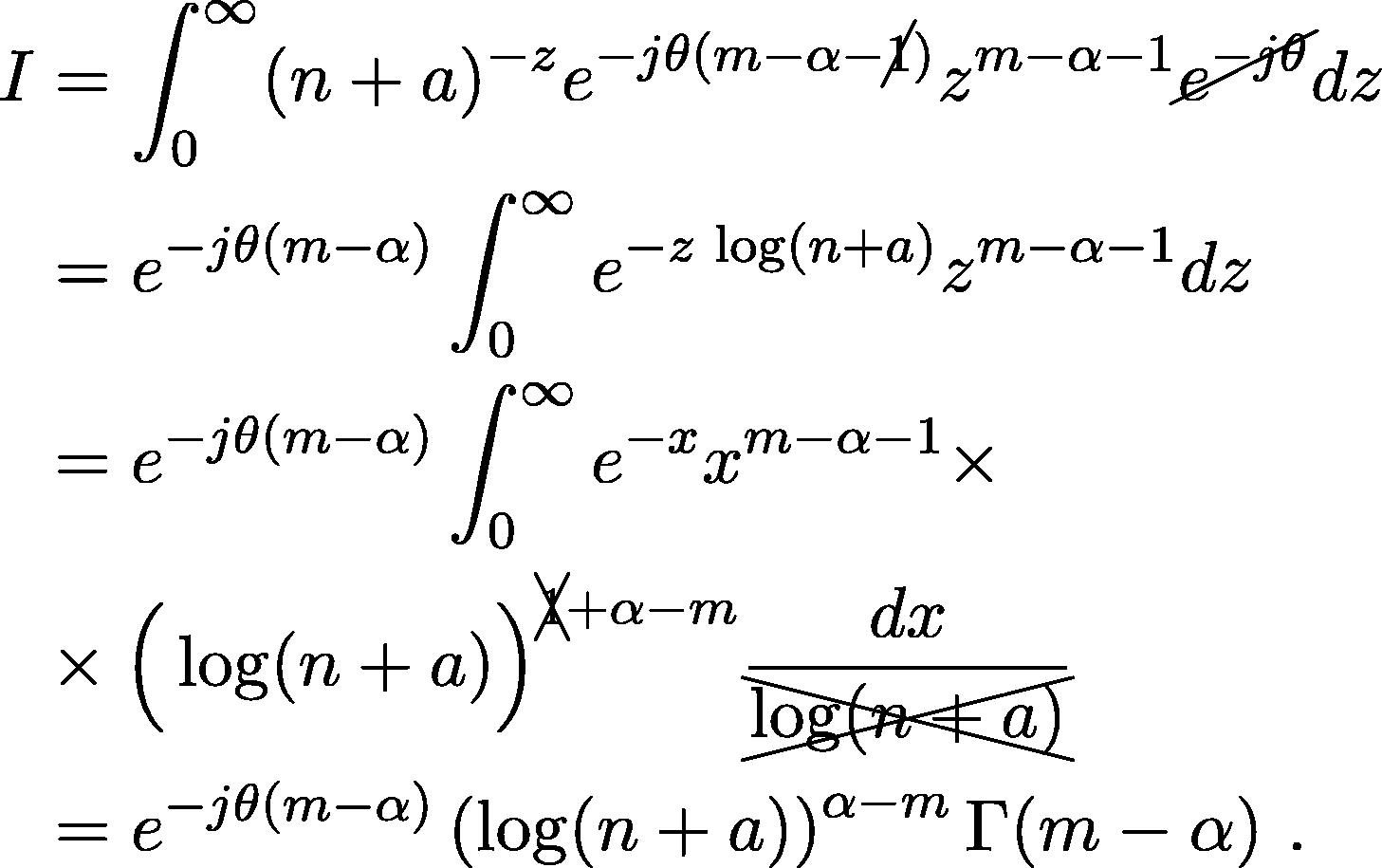
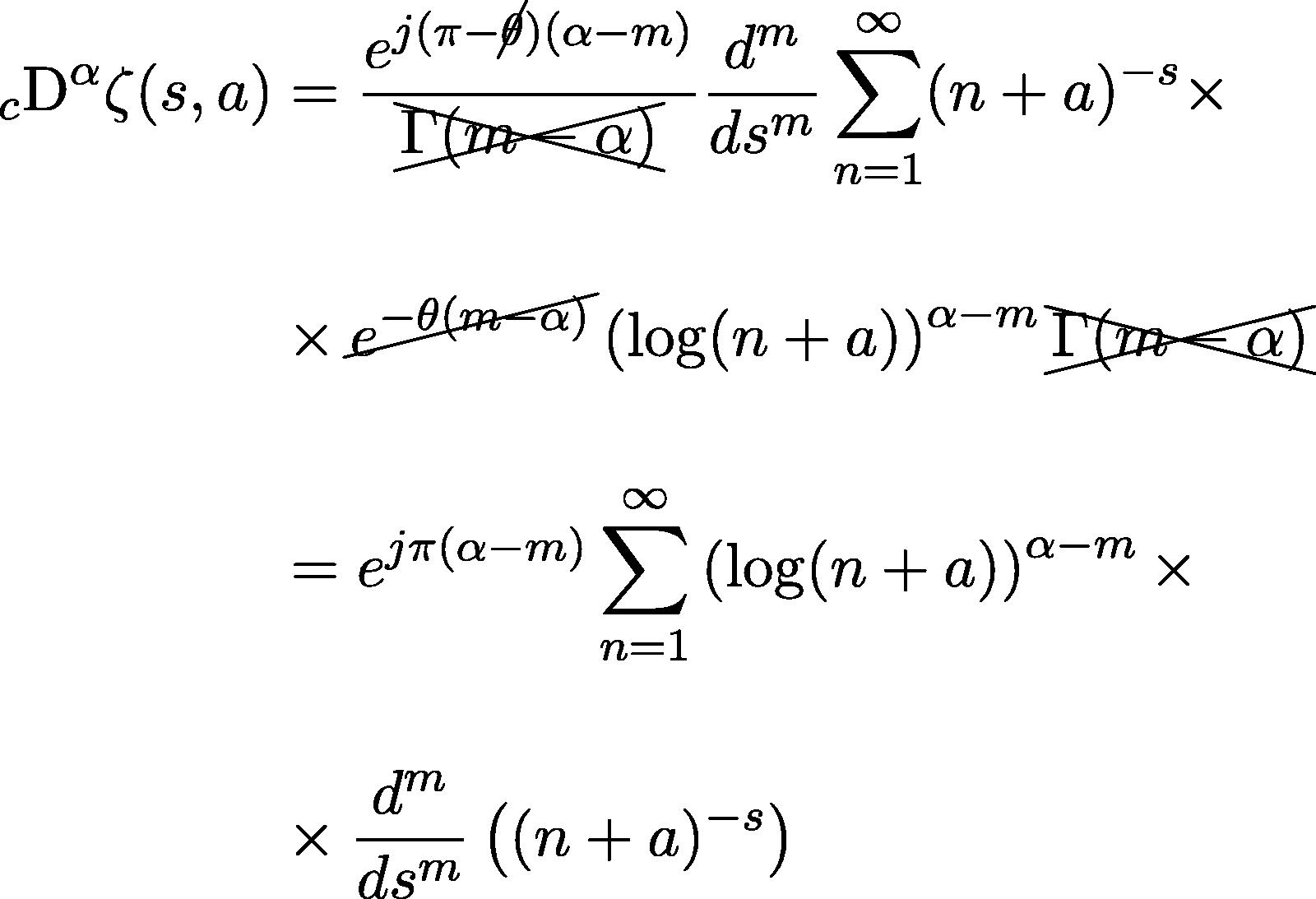
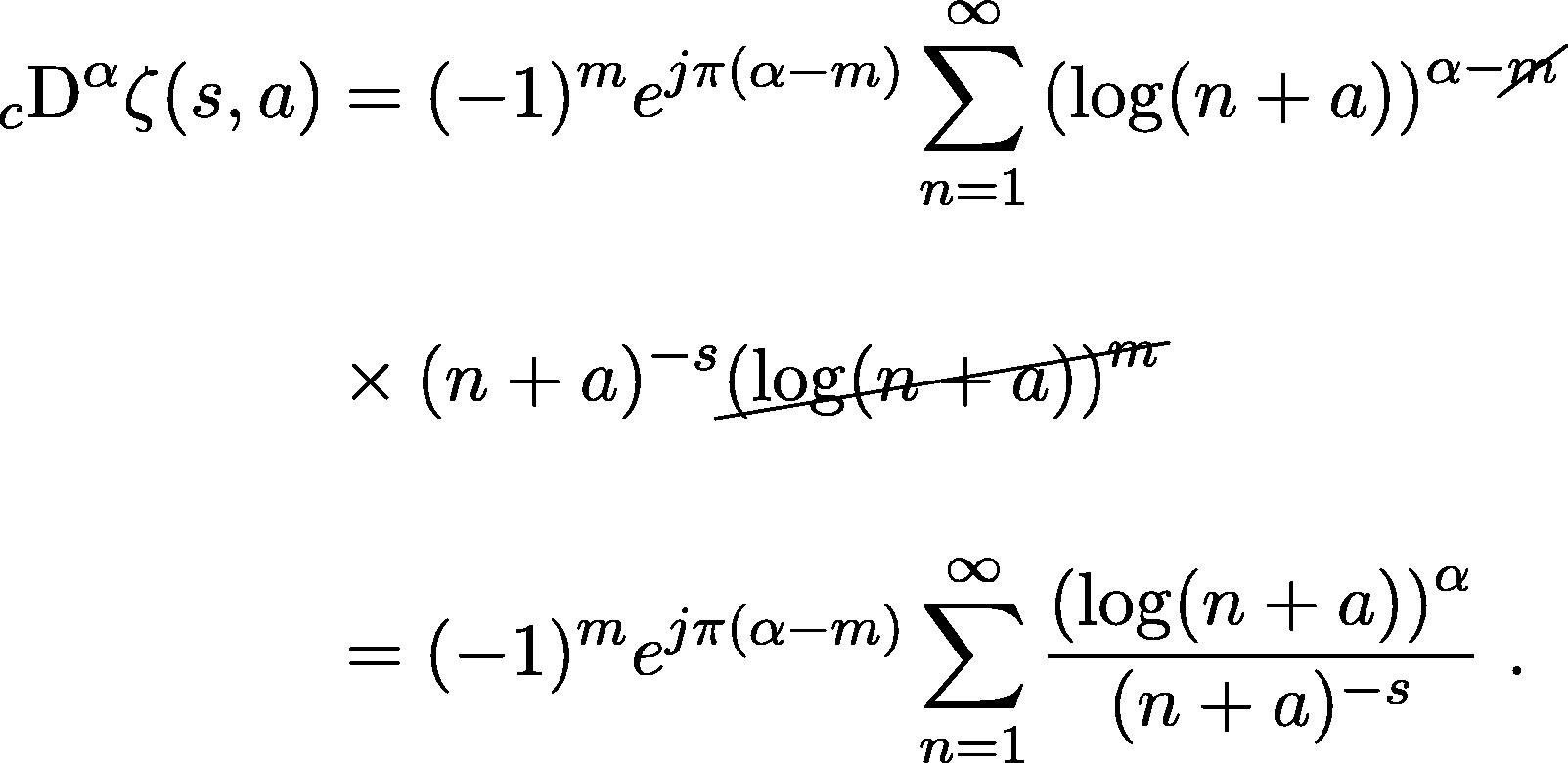
These two results (4.1) generalize, in a coherent way, what has been already considered in Guariglia (2015) for the fractional derivative of Riemann zeta function, so that the fractional derivative of the Riemann zeta function can be seen in a more general scheme. In fact, if in we put , we have , which is coherent because is a Dirichlet series with . Analogously for the Hurwitz zeta function: with in , we obtain , which is coherent because .
It should be noticed that the Ortigueira fractional derivative gives a natural generalization of the already known (integer order) derivative of the Riemann zeta function. In fact, a known result is that the derivative of integer order of the Riemann zeta function is (Apostol, 2010, chp. 12) which coincides with the Eqs. (4.1), by putting an integer order factor, and .
4.1 Some properties of the fractional derivatives (4.1)
Let us consider Eq. (4.1)1 with , i.e.
Moreover, without restricts, we set
and the constant factor
equal to 1: thus, we obtain the following function
In the case when the variable s is a pure real number
, the partial sum (for a fixed n) is a function with rapid decay to zero. For a pure complex number, i.e.
then we have a complex function whose real part (4.2)
(see Fig. 1) is a slow decay even function while the complex part
it is a slow decay odd function (Fig. 2).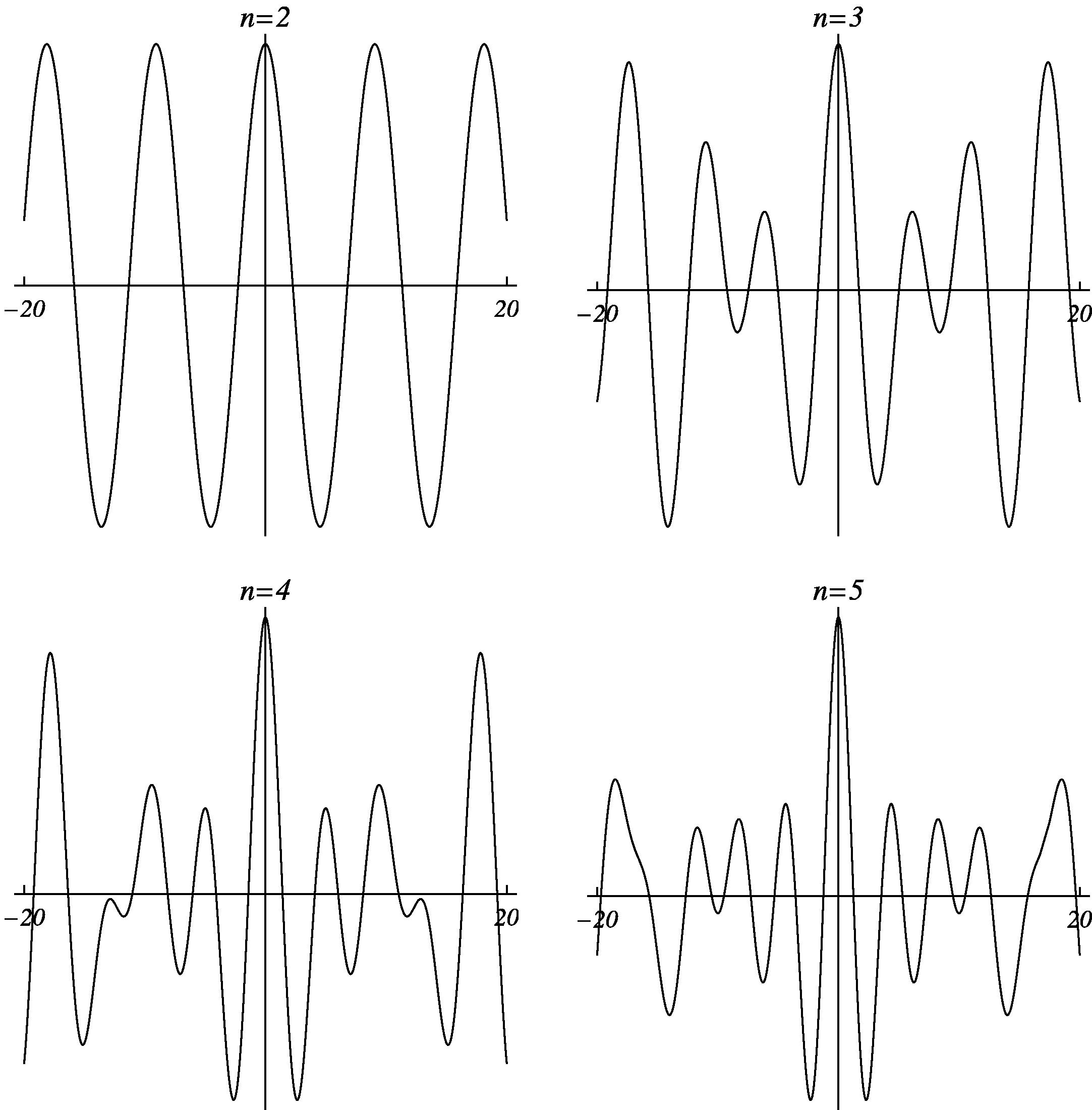
The real part of the complex function (4.2) with
and
.
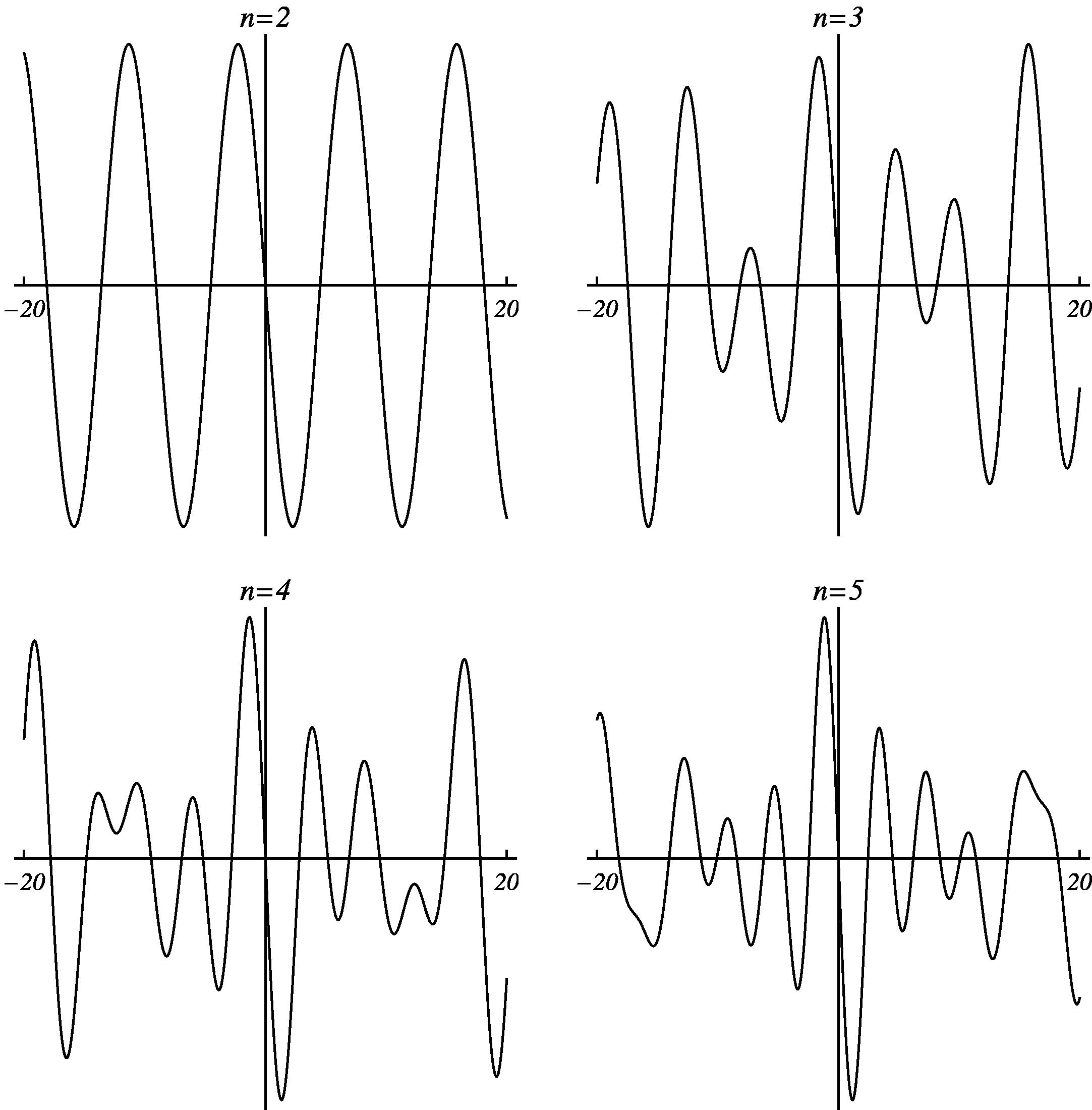
The imaginary part of the complex function (4.2) with
and
.
If we plot the real and imaginary part of the function (4.2) in the same plane, then we have the parametric plot of the complex (4.2) with
of Fig. 3.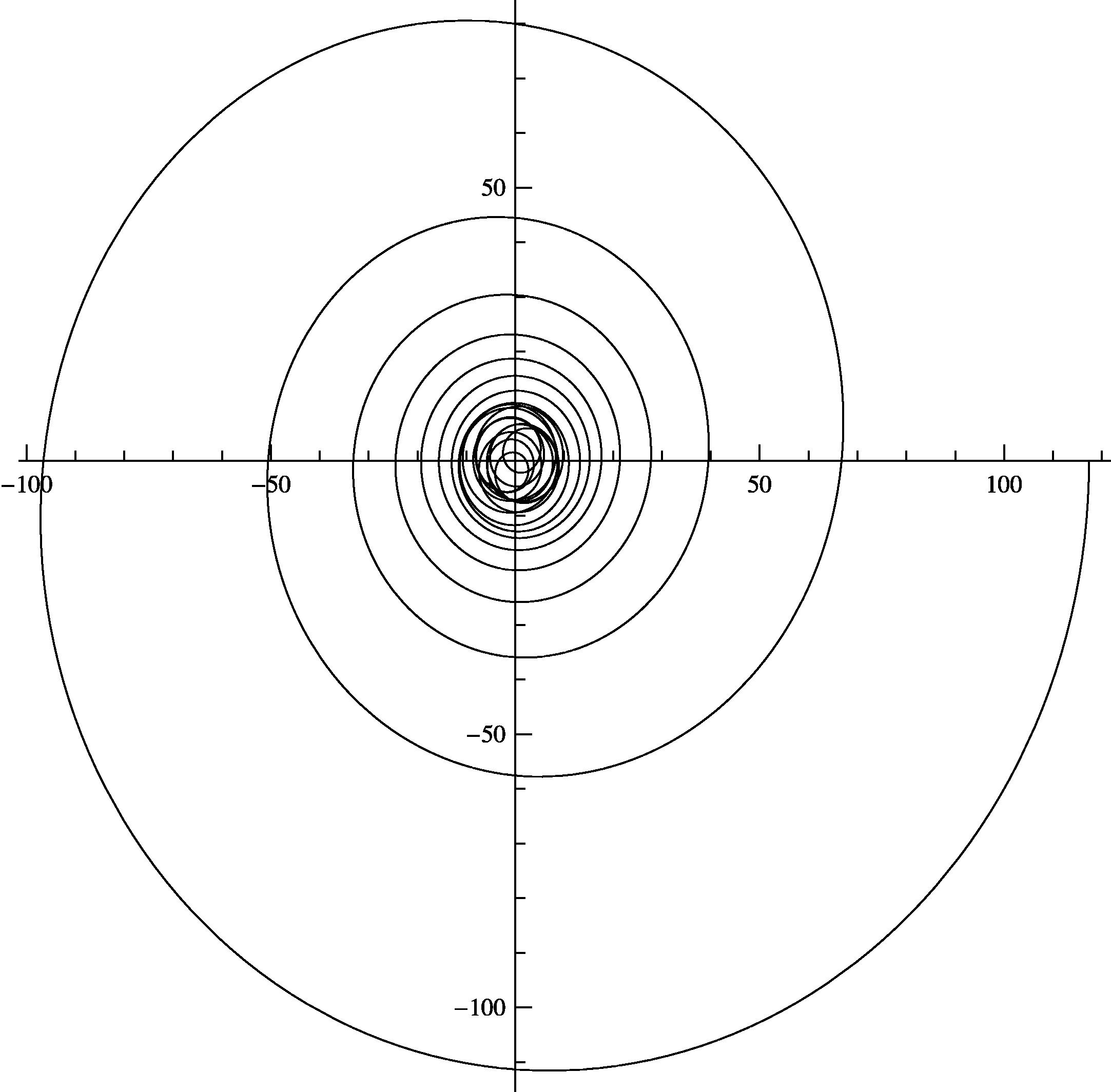
Parametric plot of the complex function (4.2) with
, the upper limit of the sum
and the upper bound of
.
We can say that the parametric plot of the fractional derivatives (4.2) of the Riemann zeta function is a spiral having the origin as an asymptotic attractor. However, if we zoom in around the origin we can see that the spiral becomes a self-intersecting non-differentiable function.
Moreover, from (4.2) by the series expansions we have being the so-called generalized Pochammer symbol.
Since it is and, for every , being we get from (4.2) Thus, for every complex number , it is: There follows that, apart a constant factor, the Ortigueira fractional derivative of the Riemann zeta function can be also expressed as a complex power series (by the Pochammer symbol).
5 Conclusion
In this paper the integer order derivative of the Riemann zeta function has been generalized to fractional order derivative. This generalization has been obtained using the Ortigueira definition of fractional derivative of complex function which has been applied to the Hurwitz zeta function and to a Dirichlet series. The fractional derivative of the Riemann zeta function has been studied to show some interesting properties, such as a chaotic decay to zero (in the Gaussian plane) and a promising expression as a complex power series. The chaotic decay might suggest that the fractional derivative of the Riemann zeta function is non-differentiable function around zero. Thus opening new perspectives in the applications to the theory of dynamical systems.
References
- Abramowitz M., Stegun I.A., eds. Handbook of Mathematical Functions With Formulas, Graphs, and Mathematical Tables, NBS Applied Mathematics Series 55. Washington, D.C.: National Bureau of Standards; 1964. p. :150-159.
- Introduction to Analytic Number TheoryUndergraduate Texts in Math (fifth ed.). Springer; 2010.
- On the equivalence of the Riemann-Liouville and the Caputo fractional order derivatives in modeling of linear viscoelastic materials. Fract. Calculus Appl. Anal.. 2010;10(2):123-126.
- [Google Scholar]
- Beliakov, G., Matiyasevich, Y., 2014. Approximation of Riemanns zeta function by finite Dirichlet series: multiprecision numerical approach. arXiv: 1402.5295v1 [math.NT].
- A fully spectral collocation approximation for multi-dimensional fractional Schrodinger equations. J. Comput. Phys. 2015:120-131.
- [Google Scholar]
- On the Caputo operator of fractional calculus and C-Laguerre function. Math. Sci. Res. J., N.. 2005;9:161-170.
- [Google Scholar]
- On Taylors coefficients of the Hurwitz zeta function. JP J. Algebra Number Theory Appl.. 2008;12(1):103-112.
- [Google Scholar]
- Linear model of dissipation whose Q is almost frequency independent-II. Geophys. J.R. Astr. Soc.. 1967;13:529-539.
- [Google Scholar]
- Fractal patterns in prime numbers distribution. In: Cattani C., Taniar Fractal patterns in prime numbers distribution. In: D., Gervasi O., Murgante B., Pardede E., Apduhan B.-O., Taniar D., Gervasi O., Murgante B., Pardede E., Apduhan B.-O., eds. Computational Science and its Applications - ICCSA 2010. Berlin Heidelberg: Springer; 2010. p. :164-176.
- [Google Scholar]
- A review of definitions for fractional derivatives and integrals. Math. Probl. Eng.. 2014;2014:238459.
- [Google Scholar]
- The Prime Obsession. New York: Plume Books; 2004.
- Zeta Function. New York: Academic Press; 1974.
- Fractional analysis of Riemann zeta function. In: Cattani C., Srivastava H., Yang X.J., eds. Fractional Dynamics. Krakow: Springer; 2015. chp. 22
- [Google Scholar]
- Divergent Series. New York: Chelsea Publishing Co.; 1991.
- The zeros of Riemanns zeta-function on the critical line. Math. Z.. 1921;10(3-4):283-317.
- [Google Scholar]
- An Introduction to the Theory of Numbers (6th edition). Oxford University Press; 2008.
- Riemann-Liouville integrals of fractional order and extended KP hierarchy. J. Phys. A: Math. Gen.. 2002;35:96579670.
- [Google Scholar]
- Advanced Topics on Applications of Fractional Calculus on Control Problems, System Stability and Modeling. WSEAS Press; 2014.
- Fractional derivatives in complex planes. Nonlinear Anal. Theory Methods Appl.. 2009;71(5-6):1857-1869.
- [Google Scholar]
- Local fractional Z transforms with applications to signals on Cantor sets. Abstr. Appl. Anal.. 2014;638648
- [Google Scholar]
- Complex Analysis for Mathematics and Engineering (third ed.). Jones & Bartlett Learning; 1997.
- Fundamental Number Theory with Applications (second ed.). Boca Raton, London, New York: CRC Taylor & Francis Group; 2008.
- Advanced Number Theory with Applications (second ed.). Boca Raton: CRC Taylor & Francis Group; 2010.
- A coherent approach to non-integer order derivatives. Signal Process.. 2006;86:2505-2515.
- [Google Scholar]
- Pozdnyakov, D., 2012. Physical interpretation of the Riemann hypothesis.
- Riemann, G.F.B., 1859. Ueber die Anzahl der Primzahlen unter einer gegebenen Grösse (i.e. On the Number of Primes Less Than a Given Magnitude), in Monatsberichte der Kniglich Preuischen Akademie der Wissenschaften zu Berlin.
- Quantum mechanical potentials related to the prime numbers and Riemann zeros. Phys. Rev. E. 2008;78:056215.
- [Google Scholar]
- Sierra, G., 2010. A physics pathway to the Riemann hypothesis, arXiv.org.
- Fractional vector calculus and fractional Maxwells equations. Ann. Phys.. 2008;323(11):2756-2778.
- [Google Scholar]
- Wang, X., 2012. Fractional geometric calculus: toward a unified mathematical language for physics and engineering. In: Proceedings of The Fifth Symposium on Fractional Differentiation and its Applications (FDA12), Hohai University, Nanjing, China, 14-17 May 2012.
- A Course of Modern Analysis (4th edition). Cambridge University Press; 1927.
- Cantor-type cylindrical-coordinate method for differential equations with local fractional derivatives. Phys. Lett. A. 2013;377(2830):1696-1700.
- [Google Scholar]
- Local fractional series expansion method for solving wave and diffusion equations on Cantor sets. Abstr. Appl. Anal.. 2013;2013 Article ID 351057
- [Google Scholar]
- Maxwells equations on Cantor sets: a local fractional approach. Adv. High Energy Phys.. 2013;2013 Article ID 686371
- [Google Scholar]







